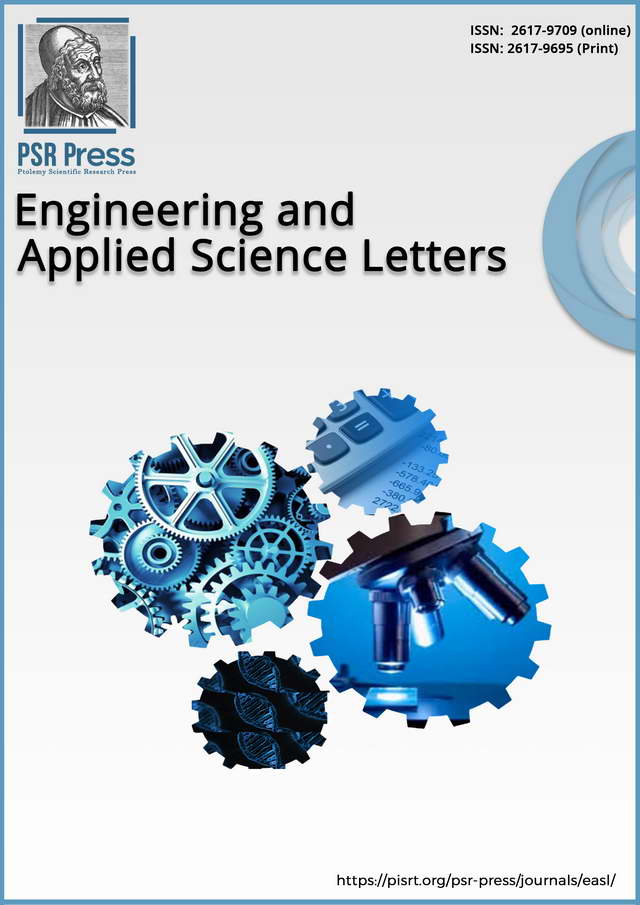Engineering and Applied Science Letters (EASL), an international and interdisciplinary open-access scientific journal, publishes regular research papers, short notes and survey papers. Our aim is to encourage scientists to publish their experimental and theoretical researches in as much detail as possible. There is no restriction on the length of the papers. Full experimental and/or methodical details must be provided, so that the results can be reproduced and published.
Subject Areas
Mathematics: Fixed Point Theory, Integrability, Numerical Analysis, Mathematical Physics, Lie groups, Graph Theory, Mathematical Inequalities, Isometry, Topology, Algebra, Geometry, Stochastic Processes, Boundary Value Problems, Linear Operators, Number Theory, Approximation Theory, Functional Analysis, Information Theory.
Engineering: Electrical engineering, Computer engineering, Electronic engineering, Power Engineering, Mechanical engineering, Manufacturing engineering, Thermal engineering, Automotive engineering, Aerospace engineering, Applied engineering, Automation/Control systems/Robotics, Electronics Engineering, Biomedical engineering, Energy engineering, Industrial engineering, Systems engineering, Mechatronics, Nano engineering, Nuclear engineering, Petroleum engineering, Chemical Engineering, Civil Engineering.
Biology: Bacteriology, Biochemistry, Biodiversity, Bioethics, Bioinformatics, Biomathematics, Biophysics, Biostatistics, Botany, Cell Biology, Conservation, Developmental Biology, Education in Biology & related disciplines, Entomology, Evolutionary Biology, Genetics, Genomics, Immunology, Marine Biology, Mathematical Biology, Medicine, Microbiology, Molecular Biology, Neurobiology, Neuroscience, Ornithology, Paleobiology, Paleontology, Parasitology, Pharmacology, Physiology, Plant Biology, Proteomics, Radiation Biology, Reproductive Biology, Structural Biology, Systems Biology, Virology, Zoology.
Chemistry: Analytical Chemistry, Biochemistry & Biological Chemistry, Bioorganic Crystal Chemistry, Biophysics, Catalysis, Chemical Kinetics & Reactivity, Chemical Physics, Coordination Chemistry, Crystallography, Electrochemistry, Electrochemical Modelling, Environmental Chemistry. EPR Specroscopy, Fluorescence Spectroscopy, Hydrogen Technologies, Hydrogen Storage, Inorganic Chemistry, Macromolecules & Polymers, Materials, NMR Spectroscopy, Nucleation & Growth of new Phases, IR & Raman Spectroscopy, Organic Chemistry, Organometallic Chemistry, Pharmaceutical Chemistry, Photochemistry, Physical Chemistry, Physical Organic Chemistry, Radiochemistry & Nuclear Chemistry, Supramolecular Chemistry & Nanochemistry, Solid State Chemistry, Spectroscopy, Surface Chemistry & Colloids, Thermodynamics, Biomaterials, Natural Product Chemistry, Medicinal Chemistry.
Physics: Acoustics, Astrophysics, Atomic & Molecular Physics, Biological & Medical Physics, Complex Networks, Socio- & Econophysics, Computational Physics, Condensed Matter Physics, Cosmology & Gravitation, Fluid Mechanics, Geophysics, Nanophysics, Optics & Lasers, Particle & Nuclear Physics, Plasma Physics, Statistical & Nonlinear Physics, Surface Physics, Theoretical & Mathematical Physics.

